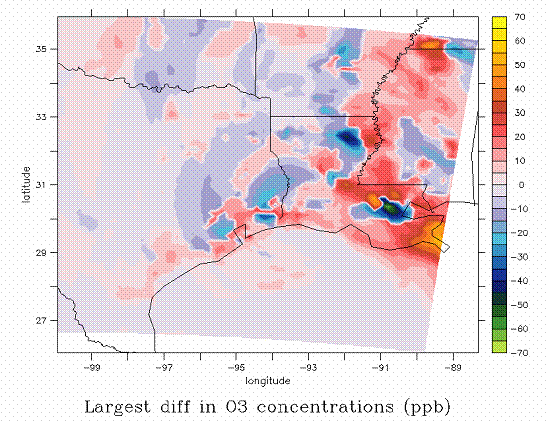AIR
QUALITY FORECASTING
Pour-Biazar,
A., R. T. McNider, S. J. Roselle, R. Suggs, G.
Jedlovec, D. W. Byun, S. Kim, C. J. Lin, T. C.
Ho, S. Haines, B. Dornblaser, R. Cameron (2007),
Correcting photolysis rates on the basis of satellite
observed clouds, J. of Geophys. Res., 112, D10302,
doi:10.1029/2006JD007422. Full
Text
In this study, we
introduce a technique for using the satellite observed
clouds to correct photolysis rates in photochemical
models. This technique was implemented in EPA’s
Community Multiscale Air Quality modeling system
(CMAQ) and was tested over a ten day period in August
2000 that coincided with Texas Air Quality Study
(TexAQS).
Use of satellite
observed clouds significantly improved model predictions
in areas impacted by clouds. The results indicated
that inaccurate cloud prediction in the model can
significantly exaggerate or under-predict ozone concentration.
Cloud impact is acute and more pronounced over the
emission source regions and can lead to large errors
in the model predictions of ozone and its by-products.
At some locations the errors in ozone concentration
reached as high as 60 ppb which was mostly corrected
by the use of our technique. Clouds also increased
the lifetime of ozone precursors leading to their
transport out of the source regions and causing further
ozone production down-wind. Longer lifetime for nitrogen
oxides (NOx=NO+NO2) and its transport over regions
high in biogenic hydrocarbon emissions (in the eastern
part of the domain) led to increased ozone production
that was missing in the control simulation. Over
Houston-Galveston Bay area, the presence of clouds
altered the chemical composition of the atmosphere
and reduced the net surface removal of reactive nitrogen
compounds.
Errors arising from
an inconsistency in the cloud fields seem to be significant
and can impact the performance of photochemical models
used for case studies as well as for air quality
forecasting. Air quality forecast models often use
the model results from the previous forecast (or
some adjusted form of it) for the initialization
of the new forecast. Therefore, errors due to incorrect
cloud specification will affect the initialization
fields and can propagate into the future forecasts.
Thus, the use of observed clouds in the preparation
of initial concentrations for air quality forecasting
could be beneficial.

Figure
7. (b) Errors in ozone concentration due to inaccurate
cloud fields can be as high as 70 ppb. This
figure shows the largest differences in O3 between
assimilation and control simulations (assim-control)
for the entire period of study covering from 0
GMT, August 24, 2000, to 0 GMT, September 2, 2000.
|